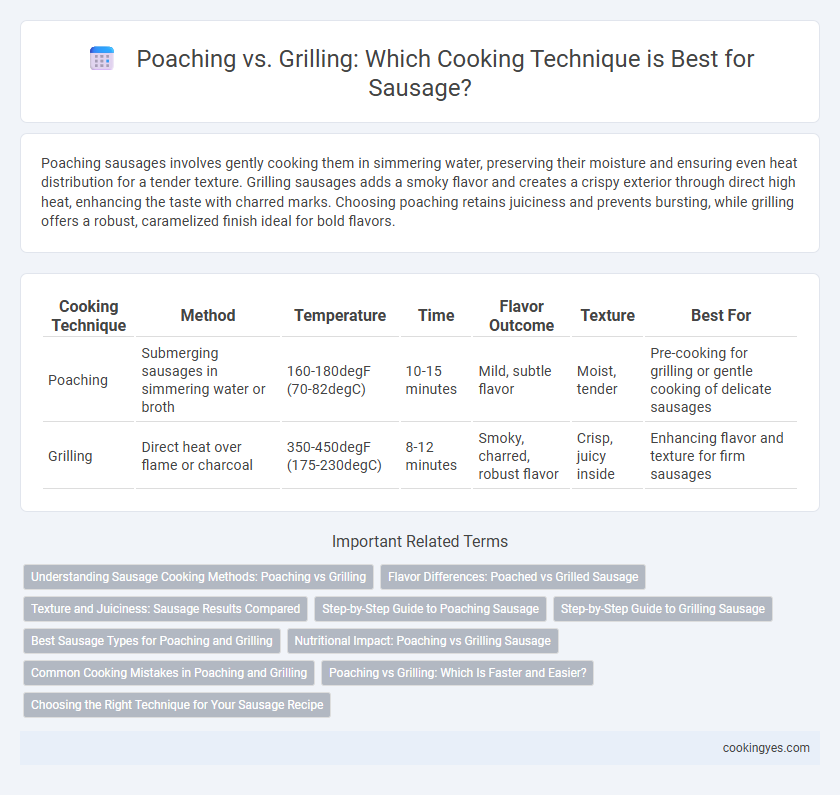Poaching sausages involves gently cooking them in simmering water, preserving their moisture and ensuring even heat distribution for a tender texture. Grilling sausages adds a smoky flavor and creates a crispy exterior through direct high heat, enhancing the taste with charred marks. Choosing poaching retains juiciness and prevents bursting, while grilling offers a robust, caramelized finish ideal for bold flavors.
Table of Comparison
| Cooking Technique | Method | Temperature | Time | Flavor Outcome | Texture | Best For |
|---|---|---|---|---|---|---|
| Poaching | Submerging sausages in simmering water or broth | 160-180degF (70-82degC) | 10-15 minutes | Mild, subtle flavor | Moist, tender | Pre-cooking for grilling or gentle cooking of delicate sausages |
| Grilling | Direct heat over flame or charcoal | 350-450degF (175-230degC) | 8-12 minutes | Smoky, charred, robust flavor | Crisp, juicy inside | Enhancing flavor and texture for firm sausages |
Understanding Sausage Cooking Methods: Poaching vs Grilling
Poaching sausage involves cooking it gently in simmering water or broth, preserving moisture and ensuring even heat distribution for a tender texture. Grilling sausage exposes it to direct high heat, creating a crispy exterior and smoky flavor through caramelization and Maillard reactions. Choosing between poaching and grilling depends on the desired sausage texture, flavor intensity, and cooking control.
Flavor Differences: Poached vs Grilled Sausage
Poaching sausage preserves its moisture and produces a tender, juicy texture with subtle, delicate flavor notes. Grilling sausages imparts a smoky, charred taste and a crispy exterior, enhancing the spice profile and creating a caramelized crust. The cooking method dramatically influences flavor intensity, with poaching highlighting sausage natural juices and grilling intensifying savory aromatics through Maillard reaction.
Texture and Juiciness: Sausage Results Compared
Poaching sausages ensures even cooking and retains maximum juiciness by gently heating the meat, resulting in a tender texture with minimal moisture loss. Grilling sausages creates a crispy, caramelized exterior with a firmer texture while risking some moisture evaporation, which can reduce juiciness. Choosing between poaching and grilling affects the sausage's final mouthfeel, balancing tenderness and flavorful crust development.
Step-by-Step Guide to Poaching Sausage
Poaching sausage involves gently simmering it in water or broth at a temperature of 160-180degF to ensure even cooking without casing rupture, preserving juiciness and preventing drying out. Start by placing sausages in a single layer in a pan, covering them with liquid, then heat slowly to a gentle simmer, maintaining low heat for 10-15 minutes until fully cooked. This method enhances flavor absorption and prepares sausages for quick finishing on the grill or pan-searing for a browned exterior.
Step-by-Step Guide to Grilling Sausage
Grilling sausage involves preheating the grill to medium heat before placing the sausages directly on the grates, turning them frequently for even browning and cooking. Maintain a consistent temperature to prevent casing from splitting while ensuring internal juices remain locked in, typically grilling for 12-15 minutes. Avoid piercing the sausages to preserve moisture and use a meat thermometer to confirm an internal temperature of 160degF (71degC) for pork or beef sausages and 165degF (74degC) for poultry varieties.
Best Sausage Types for Poaching and Grilling
Poaching is ideal for delicate sausages like bratwurst, breakfast links, and weisswurst, as it gently cooks the meat while preserving moisture and tenderness. Grilling suits heartier varieties such as Italian sausage, chorizo, and kielbasa, providing a smoky flavor and crispy exterior through direct high heat. Selecting the right method enhances flavor profiles and texture, making poaching perfect for mild, fresh sausages and grilling optimal for bold, cured types.
Nutritional Impact: Poaching vs Grilling Sausage
Poaching sausage preserves more moisture and results in lower fat content as excess grease is not produced or consumed, making it a healthier cooking method. Grilling sausage allows fat to drip away, reducing total fat intake, but may promote the formation of potentially harmful compounds like heterocyclic amines (HCAs) due to high heat exposure. Nutritionally, poaching retains more vitamins and minerals, whereas grilling provides a distinct flavor profile with slightly reduced fat but potential health risks from charring.
Common Cooking Mistakes in Poaching and Grilling
Common cooking mistakes with poaching sausages include maintaining water temperatures that are too high, causing sausages to burst and lose juiciness. When grilling, a frequent error is applying excessive direct heat, which leads to uneven cooking and charred exteriors while leaving the interior undercooked. Proper temperature control during poaching and grilling ensures sausages remain tender and flavorful without drying out or breaking.
Poaching vs Grilling: Which Is Faster and Easier?
Poaching sausages is generally faster and easier because it involves cooking them gently in simmering water, which reduces the risk of burning and ensures even cooking. Grilling requires careful attention to avoid charring and takes longer due to the need for gradual heat control and flipping. For quick, hassle-free preparation, poaching is the preferred method, while grilling offers added flavor but demands more time and effort.
Choosing the Right Technique for Your Sausage Recipe
Poaching sausages ensures even cooking and preserves moisture, ideal for delicate or high-fat varieties, while grilling imparts a smoky flavor and crispy exterior best suited for heartier sausages like bratwurst or Italian links. Temperature control is crucial; poaching at 160degF to 180degF prevents casing rupture, whereas grilling requires medium-high heat to avoid burning while achieving a caramelized crust. Selecting between poaching and grilling depends on the sausage's fat content, casing durability, and desired texture, enhancing both flavor and juiciness.
Poaching vs Grilling for sausage cooking technique Infographic

 cookingyes.com
cookingyes.com